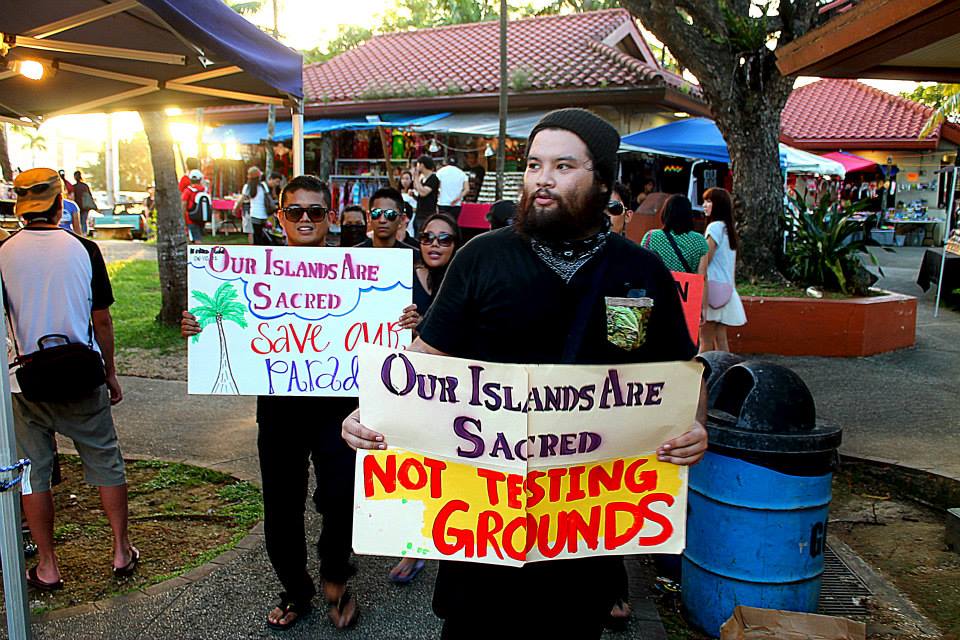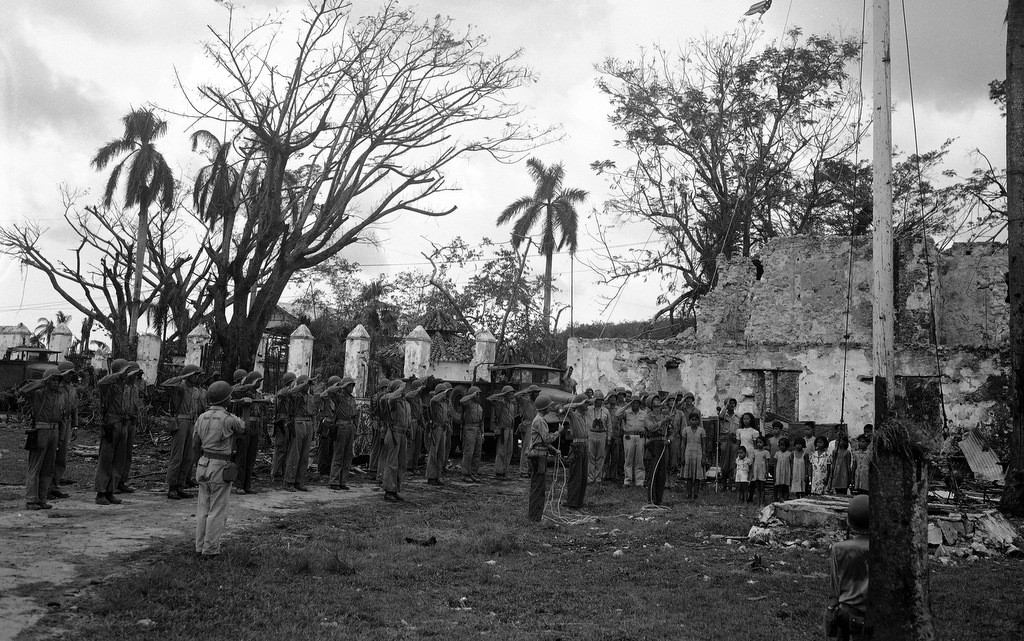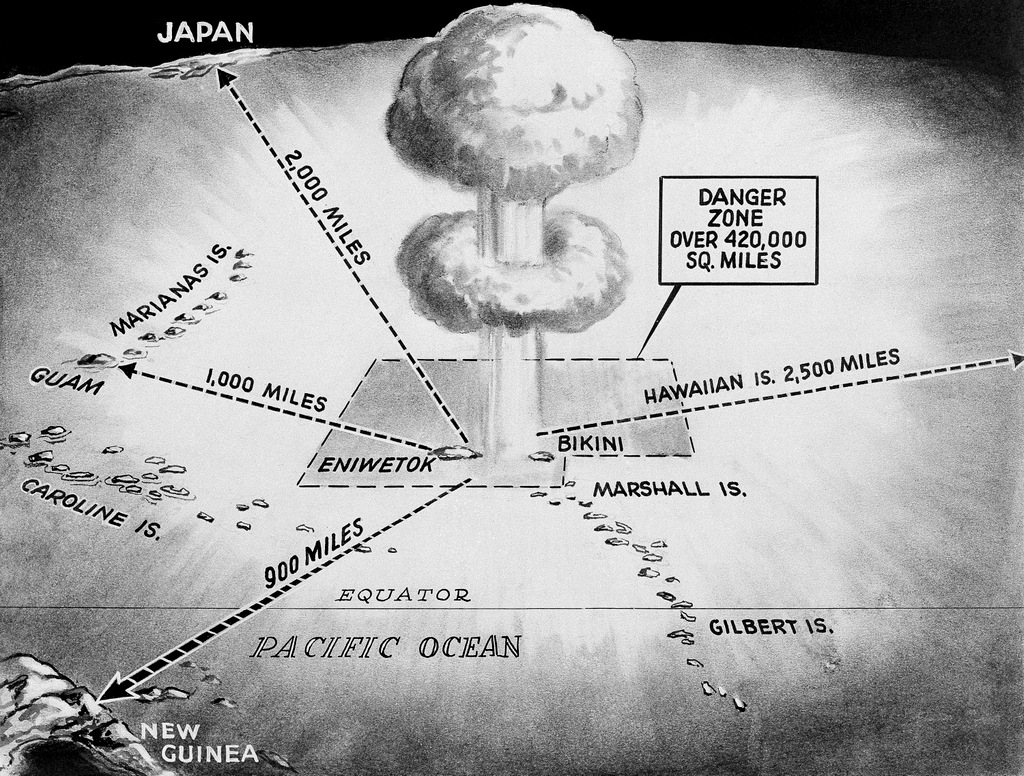
Guamanians protest the use of their land for military exercises and testing. (Photo: Michael Lujan Bevacqua)
GUAM — Tensions rose yet again earlier this week between North Korea and the United States as President Donald Trump issued his strongest threat yet to the rogue nation on Tuesday, stating at a press conference that “North Korea best not make any more threats to the U.S. They will be met with fire and fury like the world has never seen.” However, North Korea’s “threats”, which Trump referenced, have consistently been responses to overt provocations by the Trump administration.
.@POTUS: “North Korea best not make any more threats to the U.S. They will be met with fire and fury like the world has never seen.” pic.twitter.com/nUjWck9aGk
— Fox News (@FoxNews) August 8, 2017
In addition, Trump’s statements came just days after National Security Advisor H.R. McMaster hinted that the Trump administration was considering a “preventative war” targeting North Korea.
North Korea, ever defiant, responded with a new threat of its own. Just hours after Trump’s promise of “fire and fury,” North Korea’s state-run KCNA news agency reported that the country’s military could carry out “pre-emptive operations once the U.S. shows signs of provocation,” and that it is “seriously considering a strategy to strike Guam with mid-to-long range missiles.”
While Secretary of State Rex Tillerson is busily trying to mitigate the antagonism between the two nations, media reports continue to hype the possibility of a military confrontation between the United States and North Korea, a possibility that Trump himself has warned is remarkably close to becoming reality.
Despite the dangerous spark in tensions and his Secretary of State’s best efforts to prevent war, Trump has taken to boasting of the U.S.’ “most powerful” nuclear arsenal ever.
The Pentagon followed Trump’s lead, warning North Korea to ”cease any consideration of actions that would lead to the end of its regime.”
Pentagon chief Mattis: N. Korea “should cease any consideration of actions that would lead to the end of its regime” https://t.co/p6CgKokWoP pic.twitter.com/hHeX34fUwD
— CNN (@CNN) August 9, 2017
The rhetoric of both politicians and the media has, however, largely ignored the people of Guam. The Guamanians have – for over a century – been subjugated to the worst of U.S. militarism, resulting from their status as unwilling victims of U.S. colonial rule.
Guam’s history and plight as a U.S. colony
The Chamorros, the native people of Guam, first saw their island colonized by the Spanish, who held control over the Pacific island for over three hundred years — until they ceded the territory to the United States after losing the Spanish-American war in 1898.
From 1898 until 1950, the island was ruled by a U.S. naval governor, who banned the native Chamorro language from being spoken or taught. In a series of decisions from 1901 to 1922, the Supreme Court ruled that the U.S. Constitution does not apply to territories like Guam. Since then, Guam has remained a U.S. territory. Consequently, while those living on Guam are considered U.S. citizens, they are essentially voiceless — lacking meaningful political representation at the national level but still subjected to all U.S. federal laws and regulations.

Indigenous people of Guam stand aside as American officers raise an American flag, amid the ruins of Plaza de Espana, Agana, capitol of Guam, Aug. 10, 1944. (AP/Joe Rosenthal)
In response to their marginalized status, many Guamanians have sought greater representation within the United States while others have sought independence. However — as in the case of similar movements in other U.S. territories and commonwealths, such as Puerto Rico — local activism seeking greater autonomy or independence has been routinely suppressed.
It is highly unlikely that the U.S. will ever willingly give up its claim to Guam, regardless of what Guamanians themselves want. The island has long been seen by Washington as a strategic military asset for its empire. The U.S. military dominates life on Guam — currently occupying one-third of the island’s landmass as well as dominating the island’s economy.
The Pentagon moved to expand its military presence on Guam in 2009 when it announced plans to station as many as 8,600 marines on the island – a considerable force for an island of just 160,000 residents. The original plan was drafted without consulting a single Guamanian. Local protests eventually led the Pentagon to reduce the marine force’s size to 4,800. Locals, however, worry that accommodating thousands more soldiers will stress the island’s already strained infrastructure, particularly its water and wastewater systems.
Many of the island’s residents have repeatedly tried to resist the U.S.’ expansion of military bases on the island. However, as Guamanian activist, Melvin Won Pat-Borja, told Democracy Now in 2010, “We basically are forced to accept whatever it is that the United States federal government and the military decide to do.”
Bombs and chemicals take their toll
Since Guam became a U.S. colony, the U.S. government and military have consistently shown little regard for the lives of Guamanians, cementing their treatment as second-class citizens. For instance, after Japan occupied the island during World War II, the U.S. employed a carpet-bombing campaign to reclaim it. As a result, despite the brutality of the Japanese occupation, more Guamanians died from the U.S.’ efforts than died during the entire two-year occupation.
In addition, Guam’s status as a military asset has left the people of Guam, as well as the thousands of U.S. soldiers who serve on local bases, exposed to a slew of toxic chemicals and radiation that have caused island residents to experience cancer rates well above the U.S. national average.
LOL, North Korea thinks it can scare us by threatening to nuke Guam?! Hell, we used to test our OWN nukes on islands like that 70 years ago.
— Pissed Pat (@Pissed_Pat) August 9, 2017
Though the U.S. government officially denies that Agent Orange, the toxic defoliant manufactured by Monsanto, was ever used on military sites in Guam, the accounts of former U.S. servicemen and Guam residents paint a different picture. Military veterans who served in Guam, now suffering from cancer and numerous other diseases, believe that their conditions are directly linked to their time served on the island.
Several former service members have stated that they were ordered by military command to spray Agent Orange in and around military facilities and defense properties in Guam. Others reported being asked to dump barrels of Agent Orange into the Pacific Ocean. The EPA later identified over 100 sites in Guam that were found to be heavily contaminated by Agent Orange. Some Guam residents have claimed that they are living “in a virtual omnipresent mist of the rainbow herbicides.”

This drawing from 1956 shows the area in which the United States’ spring H-bomb tests took place in the Pacific Ocean. The distance of the islands with the danger zone are noted, including Eniwetok and Bikini from Japan, Guam, New Guinea and Hawaii (AP/Ed Gunder)
However, the spraying of deadly chemicals is just a footnote in the U.S.’ toxic legacy on the island. Following World War II, between 1946 and 1958, a total of 66 atomic and hydrogen bombs were “tested” (i.e., detonated) in the Marshall Islands. Six islands were vaporized and hundreds of people were irradiated, as the islands were populated at the time. Guam, which lies about 1,200 miles east of the Marshall Islands, was later shown to have received significant amounts of radiation from the blast via jet streams active at the time of the testing.
Related | U.S. Military World’s Largest Polluter – Hundreds Of Bases Gravely Contaminated
Despite high cancer rates in Guam and the testimony of former U.S. military officers attesting to the high level of radiation found on the islands while testing was ongoing, the U.S. government has refused to consider compensating Guamanian cancer patients for the radiation’s role in causing their cancers.
If North Korea does respond to “U.S. provocation” by attacking Guam, it will be just another manifestation – though an especially dire one – of the U.S. government’s proven disregard for the safety, well-being, and self-determination of Guamanians.
Source Article from http://www.mintpressnews.com/guam-voiceless-exploited-us-citizens-bomb-sights-north-korea/230713/
Related posts:
Views: 0
 RSS Feed
RSS Feed

















 August 10th, 2017
August 10th, 2017  Awake Goy
Awake Goy 







 Posted in
Posted in  Tags:
Tags: 
















